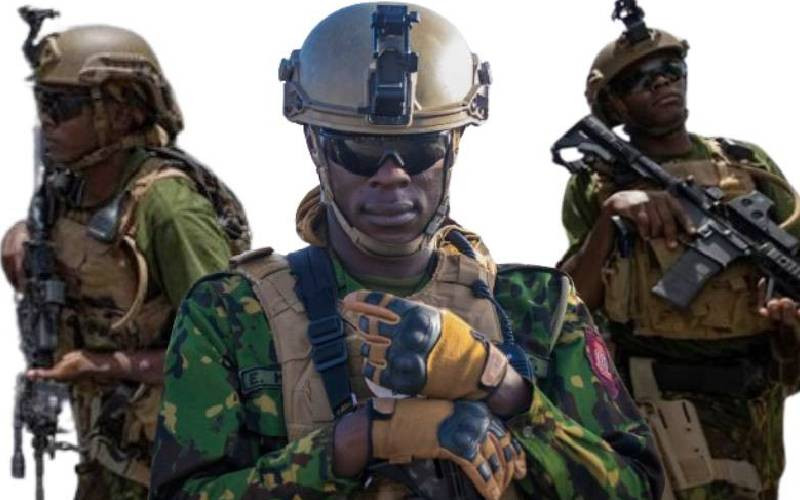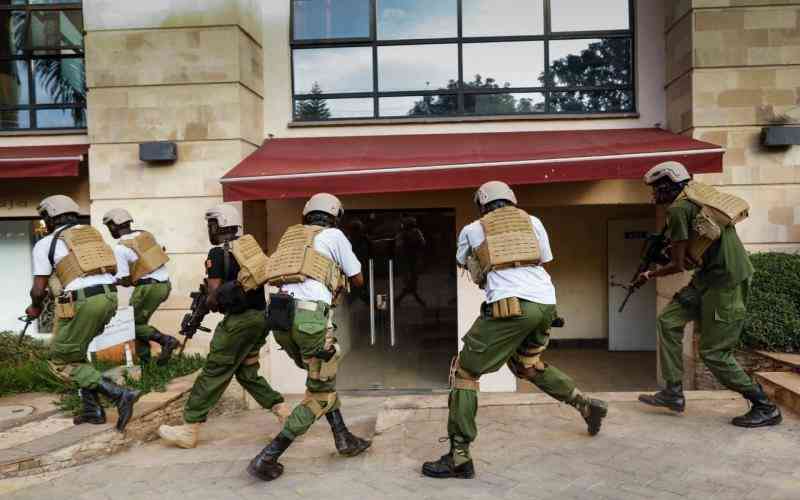 |
Prudence Bushnell, then US Ambassador to Kenya, is escorted away from the scene of the 1998 bombing.
[PHOTOS: FILE/STANDARD] |
Nairobi, Kenya: Prudence Bushnell stood frozen in her dusty high heels and debris-covered green business suit, her face contorted in disbelief. She was in the control room, quickly established at the USAid building, trying to come to terms with what had just happened.
A few hours earlier, she had been in a meeting with then Cabinet Minister Joseph Kamotho at Cooperative House. Suddenly, there had been a small explosion, followed by a flash of brilliant light. A second massive explosion had blown the windows and shaken the building. Suddenly, the US embassy was engulfed in swirling smoke, screams of anguish and tongues of flame.
The once magnificent embassy building that had stood bravely next to Ufundi Cooperative House had been reduced to a pile of rubble by 2,000 pounds of explosives packed in a pick-up truck. It was like a scene out of Beirut in the 1980s.
How did we get here?
Bushnell was the US ambassador to Kenya, having been appointed in 1996 by President Bill Clinton.
For months, it had been tough sailing through rough diplomatic waters. Her relationship with State Department contacts was probably at its lowest, partly due to her persistent – and, according to White house insiders, ‘annoying’ – push to have security at the embassy beefed up, or have the consulate relocated to a more secure environment.
In a new book, ‘Tyranny of Consensus’ by Janne Nolan, Bushnell pours her heart out on the frustrations she faced in Nairobi and the obstacles that built up to the first US embassy terror attack on African soil. The attack resulted in the death of 212 people (200 Kenyans and 12 Americans) and injuries to another 5,000.
In the book, Nolan examines three cases—the Islamic Revolution in Iran, the proxy war with the Soviet Union in Afghanistan, and the 1998 embassy bombings in East Africa—to evaluate the limitations of American policy-makers in comprehending important developments globally.
Bushnell reveals new details about the shadow boxing that went on behind diplomatic curtains. It culminates in the horrific events of August 7, 1998.
The book’s details on the East African bombings are compiled from interviews with the former ambassador, information collected from the 911 commission and the US State Department Accountability Review Board that carried out investigation into the attacks. It goes as far back as Bushnell’s observations when she arrived in Kenya.
“The first day I walked into the Chancery, I knew something had to be done. Here was an ugly, brown, square box of concrete located on one of the busiest street corners in Nairobi. We were situated across the street from the train station. Street preachers, homeless children, muggers, hacks and thousands of pedestrians came by our threshold every day,” she told a diplomatic website.
A busted al-Qaeda terror cell in Nairobi and continued reports of threats did little to assuage the ambassador.
According to the book, “the persistent and varied efforts by Ambassador Bushnell to ask for a new embassy or barring that for enhanced security measures for the existing embassy were rebuffed by a range of officials”.
Bushnell says: “I had learned before I got to Nairobi that the...Overseas Building Operations was planning a $4-7 million renovation of this building that was unsafe and much too small for us... I thought it was dumb to invest more capital in a building that would never be considered safe.”
But a stubborn ‘Pru’, as her friends call her, persisted in asking for help despite the ambivalence she faced. When she returned to Washington for consultations in December of 1997, Bushnell was told to her face to stop sending cables because officials were getting irritated.
Stay informed. Subscribe to our newsletter
Sent appeals
“After exhausting routine channels, the ambassador sent appeals to a number of senior officials, in one instance requesting a visiting State Department colleague to hand deliver a letter containing a personal entreaty to Secretary of State Madeleine Albright.”
“The letter spoke bluntly about the failure of lower level officials to act promptly and asked for secretary’s personal intervention to approve urgent measures for the embassy in Nairobi.”
But, the book says, Washington officials found her description of security threats “overblown and inaccurate”.
A new embassy for Nairobi was not on the radar, and a March 1998 State Department security review team conducted an assessment and found the embassy was “in compliance with standard established for the posts designation as ‘medium risk’”.
Even worse, the book argues that “the mounting intelligence information obtained that year and escalating presence and rising threat of al-Qaeda operations in the region consistently failed to influence the views of officials in Washington or the White House”.
In fact, the ambassador’s concerns about security were, according to the book, viewed as “instinct” and the “US Government could not take urgent action based on ‘emotional’ rationale,” according to a former National Security Council official who worked for senior White House terror expert Richard Clarke.
“The absence of hard evidence and tactical warning about when or even if the bombing plots might be executed meant the US Government had acted appropriately.”
The same official is quoted describing Ambassador Bushnell’s behaviour as “alarmist” and her demands for a new embassy as “unrealistic”.
And so, on Friday August 7, 1998, Bushnell walked to the neighbouring Cooperative House to meet Kenya’s Commerce Minister Joseph Kamotho to discuss an upcoming US trade delegation.
When their meeting was over, she recalls hearing a small explosion, followed by “incredible noise and huge percussion threw me off my feet. I thought the building was going to collapse, and I was pretty sure I was going to die.”
Minutes later, the diplomat walked woozily out of the building. A scene of destruction lay outside.
She navigated her way gingerly through the pile of rubble, a sickly haze of dust and the smell of incinerated bodies. She was astonished at what terrorists had done to the embassy building; her fears had been painfully confirmed.
The first call she received while in the crisis room was from Secretary of State Madeleine Albright.
“Why didn’t you tell me?” her voice was quaking with emotion.
“I wrote you a letter. It was delivered to you personally,” Bushnell answered curtly.
“But I never saw it!” the Secretary of State exclaimed.
Albright’s ignorance of the letter, the book says, proved “cold comfort to Bushnell as she struggled to maintain her composure amid the horrifying tangible chaos of a tragedy she had worked so hard to prevent”.
Still in the middle of trying to manage the chaos, trying to save lives and get the injured to hospital, the next incoming call was from President Bill Clinton. Surrounded by confusion and tragedy, she took the call hoping for some comfort from the world’s most powerful man. But his first question stunned her: “Have you secured the perimeter?”
The book narrates: “Sounding as if he were reading from a script prepared by an aide, the President evidently wanted to know what Bushnell had done to secure classified material inside the embassy. Whoever advised the President to express his concern for documents just moments after such a violent attack against innocent civilians may have found reason to regret it.”
“Barely containing her rage, the ambassador icily informed President Clinton that she was standing at a burning bomb site surrounded by bodies of dead and injured American embassy personnel, that she did not have time to spend chatting on the phone and that he, too, might consider turning his immediate attention to getting urgent help for the victims.”
Secure perimeter
Looking back on the phone call, Bushnell says: “His interest, indeed, was to secure the perimeter. It was not because of classified information — as ambassador, I had officially declared the building ‘compromised’ within hours of the bombing. The interest was in protecting the crime scene. I later understood better the importance of ‘securing the perimeter’, although at the time I was taken aback by concern for the building and not the people.”
Later, when investigations had commenced, the ARB (Accountability Review Board that investigated the embassy bombings in Nairobi) received a copy of the letter that Bushnell had arranged to be hand-delivered to the Secretary of State.
The letter, according to the book, had handwritten notes on the margin with the Secretary’s handwriting with instructions to the Undersecretary of State for management, Bonnie Cohen, asking her to “take responsibility for crafting a response to Bushnell reflecting whatever was consistent with existing policy guidelines”.
Albright, the book says, received a response a few weeks later, emphasising why a ‘medium risk’ post could not be considered for a new building. It suggested a few measures to bring the embassy up to standard of such a post and some “modest” budgetary increase for Nairobi despite “a climate of austerity and severe resources constraints”. It was probably too little too late.
The response to the bombing by officials in Washington, the book says showed “a virtual absence of workable mechanism that could encourage officials to learn from previous mistakes.”
The author argues: “The poor handling of the after action reporting meant that the process yielded very few new or important insights about the systemic reasons for the lapses in policy judgment, foundering instead in a cloud of idiosyncratic recriminations that included attempts to assign blame to individuals, usually at much lower levels.”
 The Standard Group Plc is a
multi-media organization with investments in media platforms spanning newspaper
print operations, television, radio broadcasting, digital and online services. The
Standard Group is recognized as a leading multi-media house in Kenya with a key
influence in matters of national and international interest.
The Standard Group Plc is a
multi-media organization with investments in media platforms spanning newspaper
print operations, television, radio broadcasting, digital and online services. The
Standard Group is recognized as a leading multi-media house in Kenya with a key
influence in matters of national and international interest.
 The Standard Group Plc is a
multi-media organization with investments in media platforms spanning newspaper
print operations, television, radio broadcasting, digital and online services. The
Standard Group is recognized as a leading multi-media house in Kenya with a key
influence in matters of national and international interest.
The Standard Group Plc is a
multi-media organization with investments in media platforms spanning newspaper
print operations, television, radio broadcasting, digital and online services. The
Standard Group is recognized as a leading multi-media house in Kenya with a key
influence in matters of national and international interest.









